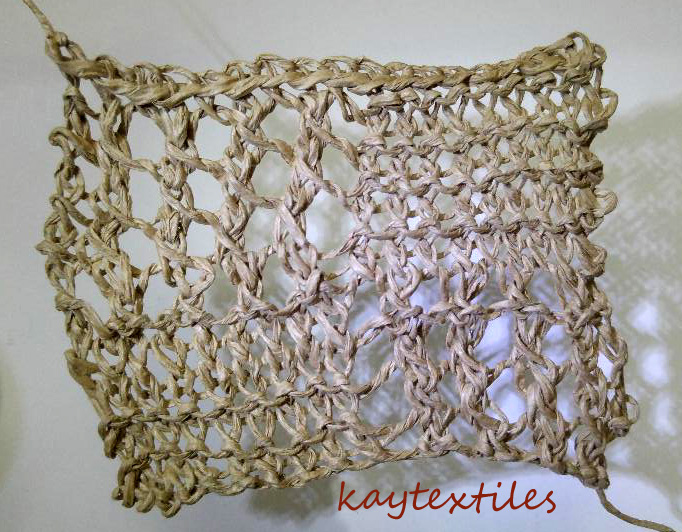Sample 1
Aim - to produce a feeling of a gull against the sky using stitching that replicates the woven texture of feathers
Background - 140gsm extra wet strength paper heavily coated with Seawhite acrylic, mixed to give a dark indigo/black and surface texture
Stitching - free machine-stitched photocopy paper soaked in water and distressed then laminated to acrylic paper with Golden Matt Medium. The remaining background also coated with Matt Medium (Image 226).
Hand stitched in detached chain stitch with variable length tails using grey variegated katia Jaipur mercerized cotton, DMC Cebelia and Finca Perle Egyptian Cotton (Image 227).
Finally the sample was given a coating back and front with paraffin wax.Sample 2
Aim - as in Sample 1 but using the open structure of the machined paper to produce shadows on a background of sea.
Background - calico coated with white emulsion and then gelli printed with acrylic paint. Gull shapes were cut from the background.
Stitching - Two of the gulls were created using the same technique as in Sample 1 but rather than a regular grid, more directional stitching was used (Image 228).
These were soaked and distressed as before and attached to the back of the sample with Golden Matt Medium. The third cut out was filled with dish cloth cotton. The sample was then waxed with paraffin wax (Image 229).
This sample could have been left as it was to produce shadows from the open grids. However, I continued to experiment with the open structures created to produce composite stitches (Image 230).
- dishcloth gull - from left - tent stitch, Swiss darning, chain stitch, stem stitch using split cream sari silk yarn; Swiss darning, chain stitch and needleweaving using grey DMC Cebelia; random cross stitch using grey variegated flower thread and grey variegated katia Jaipur cotton; needleweaving using various colours split sari silk and silk crepe yarn,
- small machine structure gull - tent stitch in split cream sari silk yarn,
- large machine structure gull - needleweaving using split cream sari silk yarn.
Sample 3 (Image 231)
Aim - to produce sampler of relevant stitches/structures
Background - calico coated with white emulsion and then gelli printed with acrylic paint. Rust, tea and turmeric cottons, machine appliqued and then coated back and front with paraffin wax (unless specified).
Stitching
- top left - Fly Stitch using crochet cotton, paper covered wire and flower thread on tea-rusted cotton (Image 232)
- middle left - Wave Stitch using crochet cotton, stranded cotton, variegated cotton on tea-rusted cotton
- bottom left - Buttonhole Rings using florist wire (Image 233) and George Weil paper yarn on tea-dyed cotton
- centre - free machine embroidery on turmeric-dyed cotton (before waxing)
- top right - French Knots using grey variegated flower thread on tea-rusted cotton
- bottom right - kantha using variegated mercerised cotton on tea-rusted cotton (not waxed).
Observations
I have used acrylic wax in previous samples and found it to enhance the colour, e.g. Images 165 and 167. It was, therefore, a surprise to find that surface treatment with paraffin wax deadened the colour of the turmeric-dyed cotton, merging the top colour with that underneath. It gave the sample a more muted look. Sadly, I didn't take a 'before waxing' picture but the turmeric was as bright as the dyed cotton in Image 221.
It was hard to control the thickness of the application of wax. On initial application with a thick brush it was too heavy and had to be ironed off between newspaper taking care not to get the wax on the iron by using baking parchment. Ironing flattened the distressed paper grid, perhaps to its detriment.
Health and Safety - try not to get dry wax on the floor as it makes it very slippery.
Buttonhole Rings - depending on how many times you wrap the mould before starting the buttonhole covering, you can change the height of the rings. The interlocking florist wire rings worked particularly well.
Sample 4 (Image 234)
Aim - to produce sampler of relevant stitches/structures
Background - paraffin waxed calico, heavily waxed
Stitching - from left to right
- grey raffia couched with feather stitch using DMC Cebelia and overstitched in feather stitch using variegated flower thread
- distressed crepe sari silk feather stitched using grey variegated flower thread - note on the right how you can pull the silk along the stitch until you get the desired effect (Image 235)
- cream distressed sari silk feather stitched using thin grey cotton covered wire
- feather stitch using grey DMC Cebelia. Note how the needle mark leaves a cloudy ring in the paraffin wax. This can be removed (if you want to) by gently heating the wax with a hair drier.











No comments:
Post a Comment